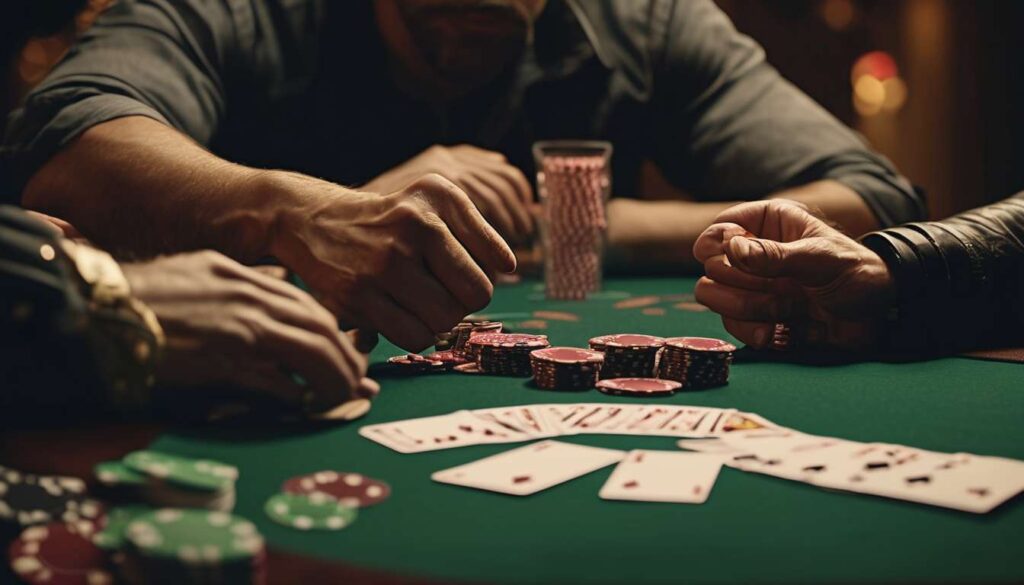In the thrilling world of poker, every hand dealt is a fresh canvas, inviting us to paint a picture of strategy, skill, and, most intriguingly, deception. We gather around the green felt, eyes darting across the table, each of us a player in this intricate dance of psychology and nerve.
As we delve deeper into the art of bluffing, we uncover patterns and behaviors that reveal more than just the cards in our hands. Our collective experiences at the table have taught us that poker is not merely a game of chance, but a battleground of wits where reading subtle cues can transform the weakest hand into a winning play.
Together, we explore the nuances of behavioral analysis in poker, aiming to understand:
- How seasoned players craft their bluffs.
- How we, as astute observers, can decipher these telltale signs.
By enhancing our own strategic arsenals, we can elevate our gameplay and gain an edge over our opponents.
The Psychology of Bluffing
Bluffing in poker relies heavily on our ability to manipulate opponents’ perceptions and emotions. This skill helps create a sense of camaraderie and shared understanding at the table.
Success in bluffing hinges on two main aspects:
-
Reading non-verbal cues:
- Every movement, from the way we handle our chips to subtle shifts in posture, tells a story.
- These non-verbal cues are a silent language that players understand and interpret to gain an edge.
-
Crafting a strategy:
- The strategy blends deception with authenticity.
- It involves creating a narrative that opponents will believe.
Projecting Emotions:
- We aim to project confidence or, at times, vulnerability to steer opponents’ decisions.
- By fostering a bond through shared glances and knowing nods, we build trust only to twist it into doubt when it suits our bluff.
The Psychology of Poker:
- Players navigate the intricate dance of psychology and perception.
- Every hand becomes a test of collective wit and resolve, making the game both challenging and engaging for all involved.
Common Bluffing Behaviors
Many poker players employ specific behaviors to disguise their intentions and mislead their opponents. When sitting at the table, a key part of our strategy involves mastering non-verbal cues that can either betray or bolster our bluffing efforts. By recognizing patterns in these behaviors, we can enhance our game and feel more connected with the poker community.
One common bluffing behavior is the exaggerated display of confidence.
- We might lean back.
- Relax our shoulders.
- Maintain steady eye contact to project a strong hand, even when holding a weak one.
Conversely, displaying nervous energy—like fidgeting or avoiding eye contact—can also be a deliberate tactic. These gestures often mask our true intentions and keep opponents guessing.
Some of us employ strategic pauses in our actions, using the time to create tension and mislead others about our hand’s strength.
- Embracing these subtle yet powerful non-verbal cues not only strengthens our bluffing strategy but also aligns us with the shared experiences of fellow players.
Recognizing Bluffing Patterns
We can sharpen our ability to recognize bluffing patterns by observing the nuances in our opponents’ behaviors and responses. As a community of poker enthusiasts, we understand that success at the table depends not only on the cards we hold but also on our capacity to read others.
Key Observations:
- By paying close attention to how players adjust their strategy in different situations, we can spot inconsistencies that indicate bluffing.
Focus on Non-Verbal Cues:
- The way someone fidgets
- Avoidance of eye contact
- Sudden changes in betting rhythm
These subtle actions can provide hints about a player’s true intentions. Developing a keen eye for these details strengthens our connection and camaraderie as we collectively work to outsmart the bluffers among us.
Sharing Experiences:
By sharing our experiences and insights, we enhance our collective understanding and improve our game. Together, we can cultivate a skillful and intuitive approach to recognizing bluffing patterns, making us formidable opponents.
Deciphering Non-Verbal Cues
We often find that the smallest gestures at the poker table speak volumes about our opponents’ intentions.
- A raised eyebrow
- A slight fidget
- A sudden glance away
These can all serve as non-verbal cues that reveal if someone’s bluffing or holding a strong hand. Our collective mission is to sharpen our awareness of these subtle signals, as they form the cornerstone of our strategy.
Together, we can decode the unspoken language of poker, turning these cues into invaluable insights.
- When we notice a player adjusting their chips nervously, it could mean they’re bluffing.
- A relaxed posture might indicate confidence in their hand.
By sharing our observations and experiences, we create a supportive community where we all grow as more intuitive players.
Let’s embrace the challenge of reading human behavior, enhancing our poker strategy with each game. By mastering non-verbal cues, we don’t just improve individually; we elevate the entire group’s understanding and success at the table.
Timing Tells in Bluffing
In poker, the timing of a player’s actions often unveils their intentions, providing us with critical insights into potential bluffs. When we observe how quickly or slowly our opponents make decisions, we’re tapping into a rich source of non-verbal cues.
- Fast bets can indicate confidence, possibly suggesting a strong hand or a well-crafted bluff.
- Conversely, a delayed action might reveal hesitation, casting doubt on the strength of their cards.
Timing tells are an essential part of our strategy, as they help us decode what lies beneath the surface of our opponents’ poker faces.
By integrating these timing observations with other non-verbal cues, we strengthen our collective understanding of the game and enhance our sense of belonging within the poker community. Together, we learn to navigate the intricate dance of bluffing and strategy, sharpening our skills in this ever-evolving game.
Let’s continue to share our insights, supporting each other in our pursuit of poker mastery.
Bluffing Frequency and Variability
Mastering the balance of how often and unpredictably we bluff is crucial in keeping our opponents guessing. In our poker community, we understand that bluffing isn’t just about bold moves; it’s a careful dance of frequency and variability. We strive to find that sweet spot where our bluffs aren’t too predictable but not so rare that they’re ineffective.
By mixing up our strategies, we keep our opponents on their toes, unsure of when we’re truly holding strong or just playing the part.
Our strategy depends heavily on reading non-verbal cues and interpreting them accurately. These subtle signals can indicate whether our opponents are comfortable or tense, helping us decide when to execute our bluff.
- We pay attention to our own non-verbal cues, ensuring they don’t give away our intentions.
Together, we practice and refine our skills, learning from each other’s successes and missteps.
Through shared experiences, we build a sense of belonging, united by our collective pursuit of poker mastery.
Gender Differences in Bluffing
In poker, we’ve observed intriguing gender differences in bluffing styles, which can significantly impact gameplay dynamics.
Men’s Bluffing Style:
- Often adopt a more aggressive bluffing strategy.
- Characterized by bold gestures and assertive non-verbal cues.
- This approach can be both intimidating and effective, altering the rhythm of the game by pushing opponents into defensive positions.
Women’s Bluffing Style:
- Tend to employ a more subtle bluffing style.
- Often rely on nuanced non-verbal cues and strategic silence.
- This approach can catch opponents off guard, as the understated nature of their bluffs may not immediately alert others to their intentions.
- Creates an inclusive atmosphere where patience and observation are rewarded.
Understanding these gender differences in bluffing not only enriches our collective strategy but also fosters a deeper appreciation for diverse playing styles.
By acknowledging these dynamics, we strengthen our community, learning from each other and celebrating the unique contributions each player brings to the table.
Adapting Your Bluffing Strategy
To enhance our poker game, adapting our bluffing strategies to exploit opponents’ tendencies and situational nuances is crucial. In the dynamic world of poker, a one-size-fits-all approach simply won’t cut it.
Observing non-verbal cues is essential. By paying attention to:
- Facial expressions
- Body language
we can gain insights into our opponents’ hands. Identifying these tells is vital in crafting a bluffing strategy that’s both flexible and effective.
Focus on timing and context:
- When we notice an opponent who frequently folds under pressure, we can confidently increase our bluffing.
- Conversely, against a seasoned player, subtlety becomes key.
It’s not just about the cards we’re holding—it’s about the narrative we weave at the table.
Practice reading the room and adjust strategies accordingly. By aligning our bluffs with the table’s pulse, we foster a sense of unity and camaraderie in our poker circle.
Adapting our strategy isn’t just smart; it’s essential for belonging in the poker community.
How has technology influenced the development of bluffing strategies in online poker compared to traditional in-person games?
Technology has revolutionized bluffing strategies in online poker, shaping a new landscape compared to traditional in-person games.
With advanced software and data analytics, players can:
- Analyze patterns
- Adapt quicker
- Exploit opponents’ weaknesses efficiently
The digital realm allows for a more strategic approach, as online platforms offer unique features that enhance decision-making processes.
This shift showcases how technology has significantly impacted the evolution of bluffing tactics in the poker world.
What role do cultural differences play in bluffing behavior and strategies across different regions?
Cultural differences greatly impact bluffing behavior and strategies in poker across regions. They shape how players perceive deception and approach mind games at the table.
Understanding these nuances can give us an edge in predicting opponents’ moves and adapting our own tactics.
Embracing diverse perspectives enriches our gameplay and helps us connect with fellow enthusiasts on a deeper level.
It’s fascinating to explore how cultural influences shape the art of bluffing in this global game.
How can artificial intelligence and machine learning be used to detect bluffing patterns in poker?
Leveraging AI in Poker Bluff Detection
We can leverage artificial intelligence and machine learning to detect bluffing patterns in poker. By analyzing player behaviors, betting tendencies, and historical data, AI algorithms can identify potential bluffs and make more informed decisions.
Benefits of AI in Poker:
- Gain insights into opponent strategies
- Improve personal gameplay
- Enhance overall performance at the poker table
With AI’s assistance, we can elevate our bluffing detection skills and stay ahead in the game.
Conclusion
In conclusion, mastering bluffing patterns in poker requires keen observation of behaviors, non-verbal cues, and timing tells.
Recognizing these signals can give you a strategic edge in the game. By understanding:
- Bluffing frequency
- Variability
- Gender differences in bluffing
You can adapt your own tactics accordingly.
Sharpen your skills in reading opponents to enhance your overall performance at the poker table.

